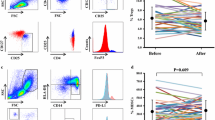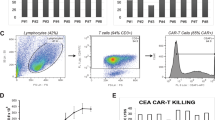Abstract
Human anti-(murine Ig) antibody (HAMA) responses were monitored in 32 patients with unresectable hepatocellular carcinoma (HCC) undergoing radioimmunotherapy using131I-labeled anti-HCC monoclonal antibody (Hepama-1 mAb) intrahepatic arterial infusion. Dosages of Hepama-1 mAb ranged from 5 mg to 20 mg and the mAb was radiolabeled with 0.74–4.00 GBq (20–108 mCi)131I (4–6 mCi/mg). T lymphocyte subsets were examined before and after radioimmunotherapy in 24 patients. In this series, 34.4% (11/32) of patients developed HAMA within 2–4 weeks after the infusion. All patients with a negative HAMA response (n=14). had CD4+ T lymphocyte subsets (T helper/inducer) much lower than those of the HAMA-positive (n=10) patients and the control group (n=40) (P<0.01) prior to infusion. The sequential resection and survival rates in the HAMA-negative group were also lower than that of the HAMA-positive group. Thus, the determination of T lymphocyte subsets might help to predict the HAMA response in HCC patients during radioimmunotherapy.
Similar content being viewed by others
References
Blottiere HM, Steplewski Z, Herlyn D, Douillard JY (1991) Human anti-murine immunoglobulin responses and immune functions in cancer patients receiving murine monoclonal antibody therapy. Hum Antibodies Hybridomas 2: 16
Chezzolini C, Grau GE, Geinoz A, Schrijvers D (1990) T lymphocyte interferon-gamma production induced byPlasmodium falciparum antigen is high in recently infected non-immune and low in immune subjects. Clin Exp Immunol 79: 95
Fan Z, Tang ZY, Liu KD, Zhou D, Lu JZ, Yuan AN, Zhao HY (1992) Radioiodinated anti-hepatocellular carcinoma (HCC) ferritin: targeting therapy, tumor imaging and anti-antibody response in HCC patients with hepatic arterial infusion. J Cancer Res Clin Oncol 118: 371
Klein JL, Leichner PK, Callahan KA, Kopher KA, Order SE (1988) Effects of anti-antibodies on radiolabeled antibody therapy. Antibody Immunoconj Radiophar 1: 55
Knox SJ, Levy R, Hodgkinson S, Bell R, Brown S, Wood GS, Hoppe R, Abel EA, Steinman L, Berger RG, Gaiser C, Young G, Bindle J, Hanham A, Reichert T (1991) Observations on the effect of chimeric anti-CD4 monoclonal antibody in patients with mycosis fungoides. Blood 77: 20
Ledermann JA, Begent RHJ, Massof C, Kelly AMB, Adam T, Bagshawe KD (1991) A phase-1 study of repeated therapy with radiolabeled antibody to carcinoembryonic antigen using intermittent or continuous administration of cyclosporin A to suppress the immune response. Int J Cancer 47: 659
Lind P, Lechner P, Hausmann, Smola MG, Koeltringer P, Steindorfer P, Cesnik H, Passl R, Eber O (1991) Development of human antimouse antibodies (HAMA) after single and repeated diagnostic application of intact murine monoclonal antibodies. Antibody Immunoconj Radiophar 4: 811
Muto MG, Finkler NJ, Kassis AI, Lepisto EM, Knapp RC (1990) Human anti-murine antibody responses in ovarian cancer patients undergoing radioimmunotherapy with the murine monoclonal antibody OC-125. Gynecol Oncol 38: 244
Oi VT, Herzenberg LA (1980) Immunoglobulin producing hybrid cell lines: In: Mishell BB, Shiigi SM (eds) Selected methods in cellular immunology. Freeman, San Francisco, p 351
Oldham RK (1984) Biologicals and biological response modifiers: fourth modality of cancer treatment. Cancer Treal Rep 68: 221
Paliard X, Maledijt W, Yssel H, Blanchard D, Chretien I, Abrams J, Vries JD, Spits H (1988) Simultaneous production of IL-2, IL-4, and IFN-γ by activated human CD4+ and CD8+ T cell clones. J Immunol 141: 849
Raziuddin S, Elawad ME (1990) Immunoregulatory CD4+CD45R+ suppressor/inducer T lymphocyte subsets and impaired cell-mediated immunity in patients with Down's syndrome. Clin Exp Immunol 79: 67
Riva P, Marangolo M, Lazzari S, Agostini M, Sarti G, Moscatelli G, Franceschi G, Spinelli A, Vecchietti G (1989) Locoregional immunotherapy of human ovarian cancer: Preliminary results. Int J Rad Appl Instrum [B] 16: 659
Schroff RW, Foon KA, Beatty SM, Oldham RK, Morgan AC (1985) Human anti-murine immunoglobulin responses in patients receiving monoclonal antibody therapy. Cancer Res 45: 879
Sears H, Herlyn D, Stepewski I, and Koprowski H (1984) The effects of monoclonal antibody immunotherapy on patients with gastrointestinal adenocarcinoma. J Biol Response Mod 3: 138
Stewart JS, Sivolapenko GB, Hird V, Davis KA, Walport M, Ritter MA, Epenetos AA (1990) Clearance of131-I-labeled murine monoclonal antibody from patients' blood by intravenous human anti-murine immunoglobulin antibody. Cancer Res 50: 563
Tang ZY, Zhou HY, Zhao G, Chai LM, Zhou M, Lu JZ, Liu KD, Havas HF, Nauts HC (1991) Preliminary result of mixed bacterial vaccine as adjuvant treatment of hepatocellular carcinoma. Med Oncol Tumor Pharmacother 8: 23
Tang ZY, Yu YQ, Zhou XD, Ma ZC, Lu JZ, Liu KD, Lin ZY, Yang BH, Fan Z, Hou Z, Zhang M (1991) Cytoreduction and sequential resection: a hope for unresectable primary liver cancer. J Surg Oncol 47: 27
Tang ZY, Zeng ZC, Liu KD, Yu YQ, Lu JZ, Xie H (1993) Intrahepatic arterial131-I anti-hepatocellular carcinoma (HCC) monoclonal antibody combined with hepatic artery ligation for treatment of unresectable HCC. Antibody Immunoconj Radiophar 6: 167
Vadhan-Raj S, Cordon-Cardo C, Carswell E, Minrzer D, Dantis L, Duteau C, Templetton MA, Oettgen HF, Old LJ, Houghton AN (1988) Phase I trial of a mouse monoclonal antibody against GD3 ganglioside in patients with melanoma: induction of inflammatory responses at tumor sites. J Clin Oncol 6: 1636
Xie H, Yang ZH, Chen RM, Yao Z, Wang BM, Guo SY, Yan ZF (1985) Two mouse hybridomas secreting monoclonal antibodies against human liver carcinoma and their antibody specificity (in Chinese). Acta Biol Exp Sinica 18: 363
Zeng ZC, Tang ZY, Xie H, Liu KD, Lu JZ, Chai XJ, Wang GF, Yao Z, Qian JM (1993) Radioimmunotherapy for unresectable hepatocellular carcinoma using131-I-Hepama-1 mAb: Preliminary results. J Cancer Res Clin Oncol 119: 257
Zhang YJ, Tang ZY, Xie H, Yuan AN, Zhao HY, Lu JZ (1991) Imaging and therapy of human hepatocellular carcinoma with radiolabeled monoclonal antibody. J Exp Clin Cancer Res 10: 243
Zimmer AM, Rosen ST, Spies SM, Goldman-Leikin R, Kazikiewicz JM, Silverstein EA, Kaplan EH (1988) Radioimmunotherapy of patients with cutaneous T-cell lymphoma using an iodine-131-labeled monoclonal antibody: analysis of retreatment following plasmaphoresis. J Nucl Med 29: 174
Author information
Authors and Affiliations
Rights and permissions
About this article
Cite this article
Zeng, ZC., Tang, ZY., Liu, KD. et al. Human anti-(murine Ig) antibody responses in patients with hepatocellular carcinoma receiving intrahepatic arterial131I-labeled Hepama-1 mAb. Preliminary results and discussion. Cancer Immunol Immunother 39, 332–336 (1994). https://doi.org/10.1007/BF01519987
Received:
Accepted:
Issue Date:
DOI: https://doi.org/10.1007/BF01519987




